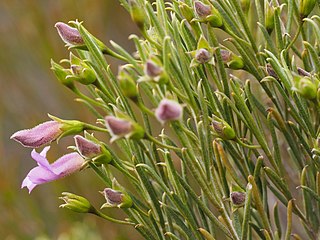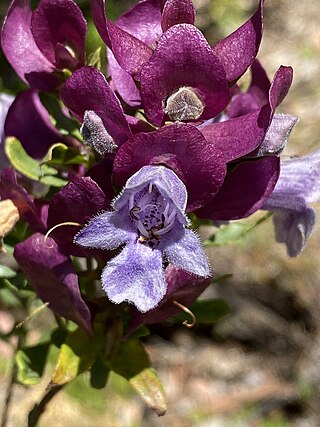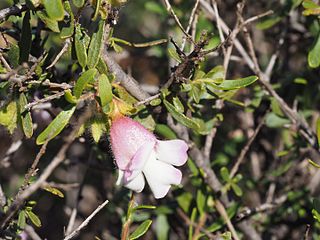
Eremophila dichroantha, also known as bale-hook eremophila, is a flowering plant in the figwort family, Scrophulariaceae and is endemic to the south-west of Western Australia. It is a shrub with many ascending branches making the plant appear broom-like. It has small, hooked leaves and small, though abundant, violet to lilac-coloured flowers.

Eremophila fraseri, commonly known as burra or jilarnu, is a flowering plant in the figwort family, Scrophulariaceae and is endemic to Western Australia. It is a shrub or small tree with all above-ground parts of the plant, apart from the petals, sticky and shiny due to the presence of a large amount of resin. The petals are coloured white, cream, pink and brown.
Eremophila coacta is a flowering plant in the figwort family, Scrophulariaceae and is endemic to a small area in the north west of Western Australia. It is an erect shrub with narrow, sticky, pointed leaves and densely hairy light to dark lilac-coloured flowers.
Eremophila gracillima is a flowering plant in the figwort family, Scrophulariaceae and is endemic to Western Australia. It is a low, spreading shrub with narrow leaves which have their edges folded under, and lilac to violet flowers. It is restricted to an area near Mount Vernon.

Eremophila granitica, commonly known as granite poverty bush and thin-leaved poverty bush is a flowering plant in the figwort family, Scrophulariaceae and is endemic to Western Australia. It is an erect, open shrub with sticky, narrow leaves and with lilac-coloured flowers.

Eremophila incisa is a flowering plant in the figwort family, Scrophulariaceae and is endemic to Western Australia. It is a low shrub with shiny leaves which have thickened teeth along their edges and hairy, mauve or purple flowers.

Eremophila jucunda is a flowering plant in the figwort family, Scrophulariaceae and is endemic to Western Australia. It is a small to medium-sized shrub with hairy branches and leaves, lance-shaped to egg-shaped leaves and cream-coloured, lilac or purple flowers.

Eremophila labrosa is a flowering plant in the figwort family, Scrophulariaceae and is endemic to Western Australia. It is a shrub with many hairy branches arising from near ground level, narrow, hooked leaves and mauve and blue flowers.

Eremophila magnifica is a flowering plant in the figwort family, Scrophulariaceae and is endemic to Western Australia. It is an erect shrub with large, clustered leaves and large, attractive lilac-coloured or purple flowers, sometimes so densely clustered that they appear like compound heads of terminal flowers.
Eremophila papillata is a flowering plant in the figwort family, Scrophulariaceae and is endemic to Western Australia. It is an erect, compact shrub with sticky, narrow leaves and mauve, blue or purple, rarely white flowers.
Eremophila pendulina is a flowering plant in the figwort family, Scrophulariaceae and is endemic to Western Australia. It is a tall, spindly, weeping shrub with narrow leaves and purple, mauve or white flowers in autumn and early spring.
Eremophila petrophila is a flowering plant in the figwort family, Scrophulariaceae and is endemic to Western Australia. It is a tall, erect, open shrub with rough branches, narrow, sticky leaves and pale lilac-coloured flowers.

Eremophila phillipsii is a flowering plant in the figwort family, Scrophulariaceae and is endemic to Western Australia. It is a tall, erect, open shrub, with narrow leaves and lilac to purple flowers which are white with purple spots inside. It often has an offensive smell.

Eremophila phyllopoda is a flowering plant in the figwort family, Scrophulariaceae and is endemic to Western Australia. It is an erect or spreading shrub, sometimes round or flat-topped with sticky, hairy leaves and flowers ranging in colour from pink or lilac to purple.
Eremophila pilosa is a flowering plant in the figwort family, Scrophulariaceae and is endemic to Western Australia. It is a small shrub with many tangled branches, with its leaves and branches densely covered with hairs and which has mauve or purple flowers. It occurs in a restricted area in the Pilbara.

Eremophila rugosa is a flowering plant in the figwort family, Scrophulariaceae and is endemic to Western Australia. It is an erect shrub with sticky, shiny leaves and pink, purple or mauve flowers.

Eremophila spinescens is a flowering plant in the figwort family, Scrophulariaceae and is endemic to Western Australia. It is a low, spreading, rigid, spiny shrub with small leaves and lilac to dark purple flowers.

Eremophila spuria is a flowering plant in the figwort family, Scrophulariaceae and is endemic to Western Australia. It is an erect, open shrub with narrow leaves and blue, lilac, purple or white flowers and is a common and widespread species.
Eremophila succinea is a flowering plant in the figwort family, Scrophulariaceae and is endemic to Western Australia. It is an erect, broom-shaped shrub with sticky, narrow, hooked leaves, narrow, sticky sepals and hairy, pale purple or mauve petals.
Eremophila viscimarginata is a flowering plant in the figwort family, Scrophulariaceae and is endemic to Western Australia. It is a small, erect, prickly shrub with hairy stems, small leaves, greenish-pink sepals and mauve petals.














